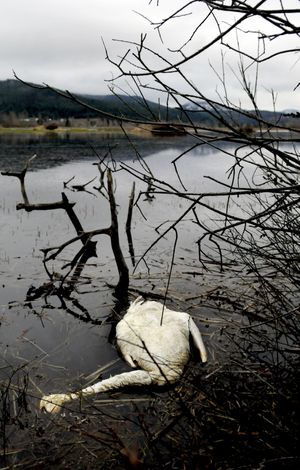Death on the lower CdA River is annual spring disgrace
ENVIRONMENT – Some people in the Inland Northwest would like to think we live in a pristine area without need for strict environmental regulations or Superfund help.
But 150 or so tundra swans each year tell us something to the contrary as they slowly die during their migration stopover on the Lower Coeur d’Alene River.
It’s not a pretty sight, but your head's in the sand if you don’t see the carnage and the reasons for it.
Read on.
Weather along the swans’ migration route dictates how long they stay in the lower Coeur d’Alene River Basin before continuing their migration to Alaska, said Julie McKarley, Idaho Fish and Game Department conservation officer in St. Maries.
A late spring such as we’re experiencing this year extends their stay and their exposure to the toxic levels of lead they absorb from contaminated sediment as they forage on roots and tubers in the marshes and lakes, McKarley said.
A century of Silver Valley mining and its waste didn’t bode well for life downstream.
If the great white waterfowl are here too long, “the lead shuts down their
digestive systems, causing the swans to gasp for air as food backs up in the esophagus and presses against the windpipe,” McKarley said. “The birds become emaciated and eventually starve to death.”
Federal research indicatesthat about 92 percent of the swan deaths along the lower Coeur d'Alene River are caused by lead poisoning.
“Approximately, 80 percent of the wetland habitats have high enough lead concentrations to be lethal to swans,” McKarley said.
“People often ask why the swans are the only animals that die because of lead poisoning,” she said. “Unlike other species of waterfowl, swans dig down to get to their forage (tubers and roots) and in the process; they ingest more contaminated soil than other animals.”
Other wildlife succumbs to the heavy metals, but McKarley describes swans as “ big white beacons in a dull marsh. People notice them and their deaths more readily.”
What’s being done?
“The best way to reduce swan mortality caused by heavy metal contaminated sediment is to provide clean wetland habitats that have low concentrations of these contaminants,” she said.
“Ducks Unlimited, the U.S. Fish and Wildlife Service, the Environmental Protection Agency and others have recently begun working to restore some of the wetland habitat in the lower Coeur d’Alene River Basin.
But to date, the program has secured only a few hundred lowland acres to be flooded for attracting waterfowl migrations to healthier stopover habitat.
Nature is dying a slow death out there right now in our near perfect place to live.

